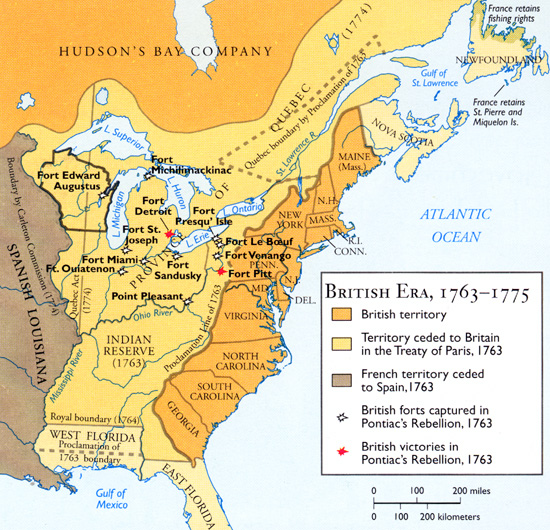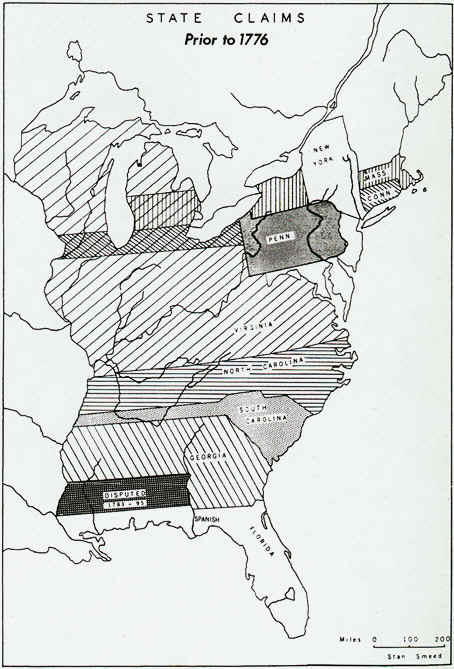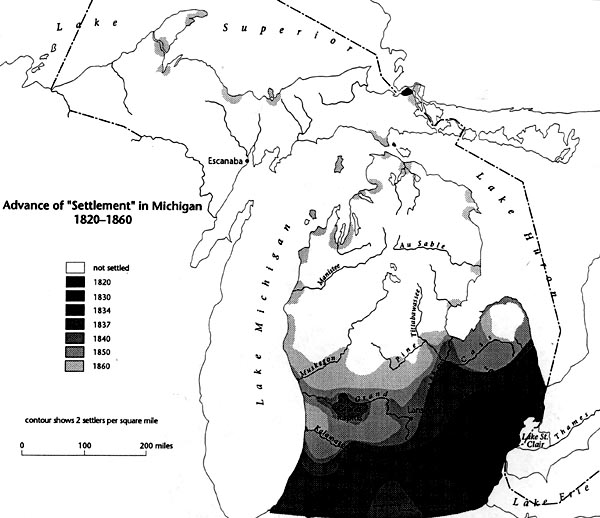The appearance of the British marked the end of a conflict between France and Great Britain for possession of inland America, involving four major wars between 1689 and 1763. Formal possession of the area now known as Michigan came with the Treaty of Paris in 1763, by which France (losers in the French and Indian War) ceded to Great Britain the St. Lawrence Valley and all lands east of the Mississippi River.
British fur-trade era, 1763-1815. As the British took control of the region (see map below), many French, Native American, and M�tis traders east of the Mississippi began working for them.
The French were rivals of the British, who undercut them by paying higher prices and selling trade goods for less and by luring the Indians with liquor and gifts. The strength of the French lay in their Indian mode of life and in their possession of key locations. The British established the great Northwest and Mackinaw Companies and gained a strong grip on the trade that continued long after the American Revolution.

Source: Atlas
of Wisconsin
When the British ousted the French from the region, the Ojibwe allied with British traders
and soldiers to drive away American settlers. The British decentralized the fur trade,
which reduced the tribes’ economic powers and led to numerous uprisings. With the
Europeans also came fatal new diseases, such as respiratory viruses, smallpox, cholera,
and measles, which decimated the Indian population and increased the survivors’
dependence on colonial trade. Growing U.S.-British conflicts led to the War of 1812, which
the British lost. After this war Britain lost control of the region and ceded to the
U.S. many of the lands that now comprise the Midwest and Great Lakes states (see map
below).
Pontiac's rebellion
The Indians favored the comradely French traders and disliked the reserved, haughty
British, whose power they seriously underestimated. They were infuriated by the sordid,
cheating adventurers who had swarmed into the West, and their resentment soon made Pontiac
the head of a great confederacy of western tribes bent on expelling the Anglo-Americans
from their hunting grounds.
But an ominous incident hinted that possession of the "water
wonderland" and its furs was not all it was cracked up to be. Around the
1760’s, a visionary appeared to the Indians, called the Delaware Prophet. This
prophet preached for the tribes to turn away from the European goods that were used in
everyday life and the holding onto the idea of the white’s disappearance. After
hearing of this man, an Ottawa Chief named Pontiac used his words to unite the Ottawa and
other regional tribes to drive the British out. Near the site of Cleveland, U.S.
Major Robert Rogers met the Ottawa chief, Pontiac (below), who for a time
lived where the Detroit River flows out of Lake St. Clair. He was already alarmed and
angry at British penetration of the West and haughtily inquired what Rogers was doing
around there without his permission!
Pontiac was an Ottawa, born about 1720 in the Detroit area. His mother
was a Chippewa and his father an Ottawa. He was raised as a member of his father's tribe.
Although little is known about his early years, as a member of the Ottawa, he probably
traded with the French fur-traders who were in the region. By 1755, Pontiac had become a
chief.
In the spring of 1763, Pontiac spearheaded a campaign that achieved
victories and made clear the Indian's discontent with the British. He hurled his
painted hordes against all the western posts. Joining with many tribal allies like the
Huron and Potawotomis, Pontiac's forces attacked the British forts, capturing eight and
forcing abandonment of a ninth fort. They took old Fort Mackinac on the south side
of the Straits and massacred most of its garrison.
Pontiac personally directed the assault on Detroit. After many
attempts, Chief Pontiac and his group of warriors failed to take this fort. These
several months of repeated attacks and failures are referred to as "Pontiac’s
Siege" or "Pontiac’s War". The Indians attacked Fort Detroit
and Fort Pitt but were unsuccessful in capturing the forts. The Indians were counting on
French support against the British in order to take these two forts. The French support
never came. As winter was getting close, many of the Indians who were fighting were
concerned about their families and went home to take care of their families. Smaller
battles continued for several years. In 1766, Pontiac signed a peace treaty at Oswego. One
of the conditions of the treaty was Pontiac was not considered guilty of any wrong and was
allowed to return home to his family who were living on the Maumee River.
Pontiac’s Legacy After the Rebellion and Even Today
After Pontiac's War, the British told settlers not to move west of the
Appalachian mountains. This land was for the Indians. However, many settlers
ignored this and moved into the frontier. As more whites moved onto the
frontier, the fighting increased. This time, Pontiac favored peace over war.
His views were not popular with many of the younger Indian warriors.
Although there are differing accounts of the demise of Pontiac, there is
some certainty that after living in obscurity for a while, Pontiac made a
visit in Illinois in 1769, a Peoria Indian from Illinois named Black Dog
stabbed and killed Pontiac. It is believed that the British might have in
fact paid Black Dog for the murder of the chief.
Although Pontiac never
achieved his dream of a united Indian front, his dream lived on and was adopted by other
Indian leaders such as Little Turtle and Tecumseh. In 1769, after living in
obscurity, Chief Pontiac was murdered by a Peoria Man in Caholina, Illinois. There
is a city named after the Ottawa Chief in Oakland County. There is also a recreation area
designated by the state called: Pontiac Lake Recreation Area. And there is also a
road leaving the city called Pontiac Lake Trail. General Motors has a car division
called Pontiac.
The American Revolution
The colonial revolution in 1775 had little impact on Michigan. The tribes believed, as
they had in 1763, that the American settlers’ voracious appetite for land threatened
their nations and ways of life. When the American colonies began to stir irritably under
British imperial policy (i.e., the American Revolution), Michigan proved to be a
dubiously valuable possession to the Brits. The garrisons in this region were costly and
perhaps the government in London was not too sorry to let the United States shoulder the
burden. U.S.-British peace talks ended the American Revolution. In the 1783 Peace
of Paris, the US unexpectedly gained control of most of the land east of the
Mississippi, and hence the rush was one to subdivide, claim, and settle these lands.
However, when its bounds were extended to the Mississippi River by the treaty of 1783
ending the Revolutionary War, Michigan was so isolated that official word from Congress
did not reach Detroit until the following August!
End of the Revolutionary War
Although Cornwallis' surrender at Yorktown in the Fall of 1781 marked the end of the
Revolutionary War, minor battles between the British and the colonists continued for
another two years. Finally, in February of 1783 King George III issued his Proclamation of
Cessation of Hostilities, culminating in the Peace Treaty of 1783. Signed
in Paris on September 3, 1783, the agreement--- also known as the Paris Peace Treaty--
formally ended the United States War for Independence. With this Treaty, the Great
lakes region became, for the first time, the property of the USA.
American fur-trade era, 1815-50.
American control of the fur trade brought more systematic business
organization and exploitation. Around 1800 the fur trade was the most valuable part of
Detroit’s commerce, and shrewd merchants reaped fortunes. The trade left an
ineffaceable impress upon Michigan’s history, for the trader had been the pathfinder
and explorer.
The U.S. prohibited foreign trade with Native nations on its territory.
The Great Lakes fur trade declined in the 1830s-1850s because of the depleted beaver
population. Native land cessions, and the subsequent removal of Native Americans to
reservations.

Source: Unknown
Britain took on the tasks of controlling the French and Native American fur trade. A rebellion led by the Odawa (Ottawa) leader Pontiac briefly united many of the western tribes against Britain. Fearing further disruptions to the fur trade, Britain began appeasing the Native nations and restraining its colonists in the new territories. The British issued the Proclamation of 1763, which drew a line along the Appalachian Mountains to keep American colonists from encroaching on a new "Indian Reserve." In 1774, the British passed the Quebec Act to increase their control of the fur trade. Neither measure worked well, and by putting the cost of maintaining the reserve on the colonies, they stoked colonist resentment that would help lead to a revolution--the American Revolution.

Source: Atlas of Wisconsin

Source: Unknown
Some of the text on this page is from:
project..ohiokids.org/ohc/history
This material has been compiled for educational use only, and may not be reproduced without permission. One copy may be printed for personal use. Please contact Randall Schaetzl (soils@msu.edu) for more information or permissions.